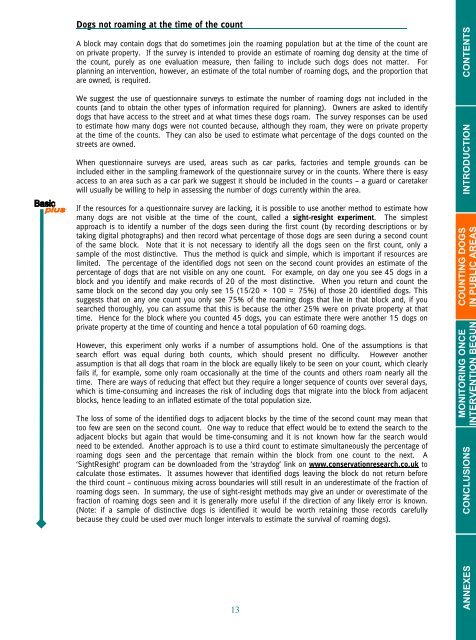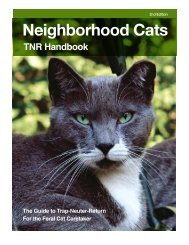Surveying roaming dog populations: guidelines ... - Animal Sheltering
Surveying roaming dog populations: guidelines ... - Animal Sheltering
Surveying roaming dog populations: guidelines ... - Animal Sheltering
Create successful ePaper yourself
Turn your PDF publications into a flip-book with our unique Google optimized e-Paper software.
Dogs not <strong>roaming</strong> at the time of the count<br />
A block may contain <strong>dog</strong>s that do sometimes join the <strong>roaming</strong> population but at the time of the count are<br />
on private property. If the survey is intended to provide an estimate of <strong>roaming</strong> <strong>dog</strong> density at the time of<br />
the count, purely as one evaluation measure, then failing to include such <strong>dog</strong>s does not matter. For<br />
planning an intervention, however, an estimate of the total number of <strong>roaming</strong> <strong>dog</strong>s, and the proportion that<br />
are owned, is required.<br />
We suggest the use of questionnaire surveys to estimate the number of <strong>roaming</strong> <strong>dog</strong>s not included in the<br />
counts (and to obtain the other types of information required for planning). Owners are asked to identify<br />
<strong>dog</strong>s that have access to the street and at what times these <strong>dog</strong>s roam. The survey responses can be used<br />
to estimate how many <strong>dog</strong>s were not counted because, although they roam, they were on private property<br />
at the time of the counts. They can also be used to estimate what percentage of the <strong>dog</strong>s counted on the<br />
streets are owned.<br />
When questionnaire surveys are used, areas such as car parks, factories and temple grounds can be<br />
included either in the sampling framework of the questionnaire survey or in the counts. Where there is easy<br />
access to an area such as a car park we suggest it should be included in the counts – a guard or caretaker<br />
will usually be willing to help in assessing the number of <strong>dog</strong>s currently within the area.<br />
If the resources for a questionnaire survey are lacking, it is possible to use another method to estimate how<br />
many <strong>dog</strong>s are not visible at the time of the count, called a sight-resight experiment. The simplest<br />
approach is to identify a number of the <strong>dog</strong>s seen during the first count (by recording descriptions or by<br />
taking digital photographs) and then record what percentage of those <strong>dog</strong>s are seen during a second count<br />
of the same block. Note that it is not necessary to identify all the <strong>dog</strong>s seen on the first count, only a<br />
sample of the most distinctive. Thus the method is quick and simple, which is important if resources are<br />
limited. The percentage of the identified <strong>dog</strong>s not seen on the second count provides an estimate of the<br />
percentage of <strong>dog</strong>s that are not visible on any one count. For example, on day one you see 45 <strong>dog</strong>s in a<br />
block and you identify and make records of 20 of the most distinctive. When you return and count the<br />
same block on the second day you only see 15 (15/20 × 100 = 75%) of those 20 identified <strong>dog</strong>s. This<br />
suggests that on any one count you only see 75% of the <strong>roaming</strong> <strong>dog</strong>s that live in that block and, if you<br />
searched thoroughly, you can assume that this is because the other 25% were on private property at that<br />
time. Hence for the block where you counted 45 <strong>dog</strong>s, you can estimate there were another 15 <strong>dog</strong>s on<br />
private property at the time of counting and hence a total population of 60 <strong>roaming</strong> <strong>dog</strong>s.<br />
However, this experiment only works if a number of assumptions hold. One of the assumptions is that<br />
search effort was equal during both counts, which should present no difficulty. However another<br />
assumption is that all <strong>dog</strong>s that roam in the block are equally likely to be seen on your count, which clearly<br />
fails if, for example, some only roam occasionally at the time of the counts and others roam nearly all the<br />
time. There are ways of reducing that effect but they require a longer sequence of counts over several days,<br />
which is time-consuming and increases the risk of including <strong>dog</strong>s that migrate into the block from adjacent<br />
blocks, hence leading to an inflated estimate of the total population size.<br />
The loss of some of the identified <strong>dog</strong>s to adjacent blocks by the time of the second count may mean that<br />
too few are seen on the second count. One way to reduce that effect would be to extend the search to the<br />
adjacent blocks but again that would be time-consuming and it is not known how far the search would<br />
need to be extended. Another approach is to use a third count to estimate simultaneously the percentage of<br />
<strong>roaming</strong> <strong>dog</strong>s seen and the percentage that remain within the block from one count to the next. A<br />
‘SightResight’ program can be downloaded from the ‘stray<strong>dog</strong>’ link on www.conservationresearch.co.uk to<br />
calculate those estimates. It assumes however that identified <strong>dog</strong>s leaving the block do not return before<br />
the third count – continuous mixing across boundaries will still result in an underestimate of the fraction of<br />
<strong>roaming</strong> <strong>dog</strong>s seen. In summary, the use of sight-resight methods may give an under or overestimate of the<br />
fraction of <strong>roaming</strong> <strong>dog</strong>s seen and it is generally more useful if the direction of any likely error is known.<br />
(Note: if a sample of distinctive <strong>dog</strong>s is identified it would be worth retaining those records carefully<br />
because they could be used over much longer intervals to estimate the survival of <strong>roaming</strong> <strong>dog</strong>s).<br />
CONCLUSIONS<br />
MONITORING ONCE COUNTING DOGS<br />
INTRODUCTION<br />
CONTENTS<br />
13<br />
ANNEXES








